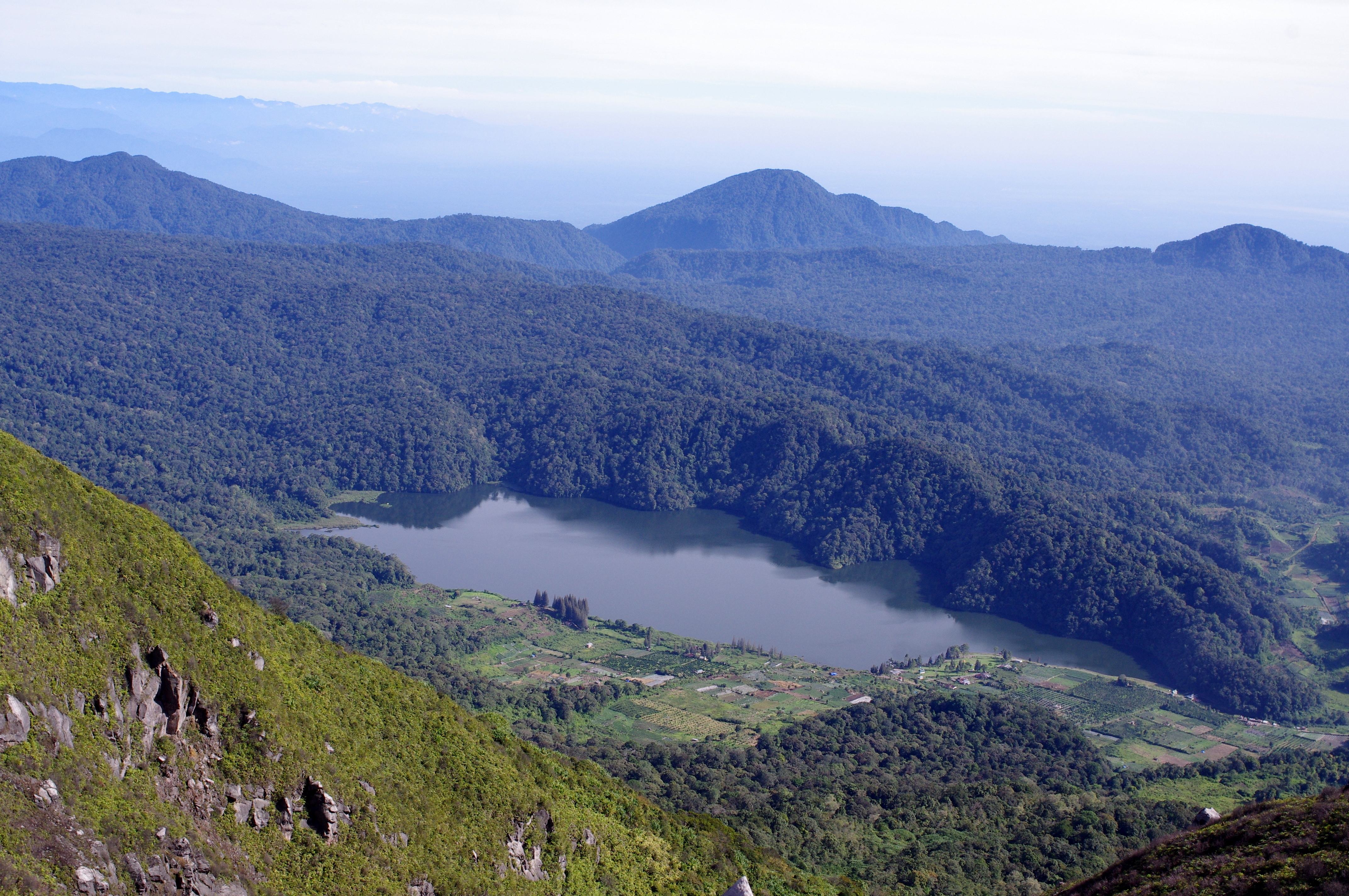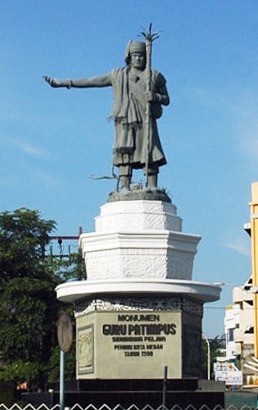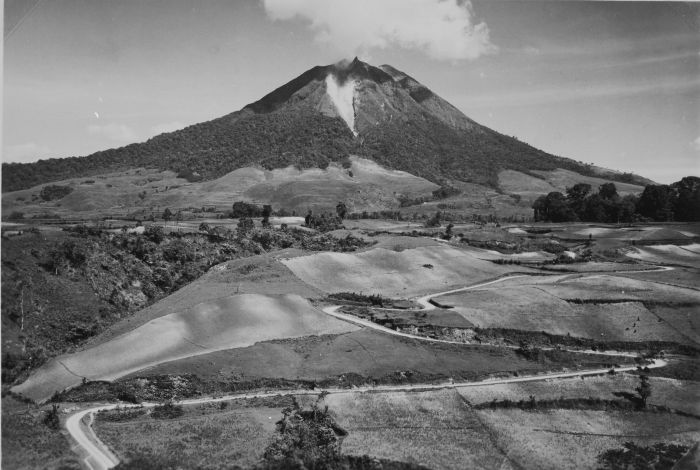|
Berastagi
Berastagi ( nl, Brastagi), is a town and district of Karo Regency situated on a crossroads on the main route linking the Karo highlands of Northern Sumatra to the coastal city of Medan. Berastagi town is located around south of Medan and about above sea level. The village rose to significance when Dutch settlers in Sumatra opened a boarding school there in the 1920s. Located in the Barisan Mountains area, the mean annual temperature of the district is . During the day the temperature rises over but at night to early morning it could drop to as low as , it could also reach during the rainy season. The weather can be fair and sunny during the day but may become foggy around dusk to night. The main economic activities in Berastagi centers on the colorful fruit and vegetable market, as well as tourism. Berastagi is famous for its passion fruit. The main attractions of the town are the two active volcanoes; Mount Sibayak, with its hot springs, and Mount Sinabung. Each mountai ... [...More Info...] [...Related Items...] OR: [Wikipedia] [Google] [Baidu] |
North Sumatra
North Sumatra ( id, Sumatra Utara) is a province of Indonesia located on the northern part of the island of Sumatra. Its capital and largest city is Medan. North Sumatra is Indonesia's fourth most populous province after West Java, East Java and Central Java, and also the most populous in the island of Sumatra. It covers an area of 72,981 km2. According to the 2020 census, the province's population in that year was 14,799,361. The mid-2021 official estimate is 14,936,148. North Sumatra is a multi-ethnic province. The Malay people are regarded as the natives of the east coast of the province, while the west coast of the province is mainly inhabited by the Batak (''Pakpak'', ''Angkola'' and ''Mandailing'' groups). The central highlands region around Lake Toba is predominantly inhabited by another ''Batak'' groups (''Toba'', ''Simalungun'' and ''Karo''). The Nias people are natives to ''Nias Island'' and its surrounding islets. With the opening of tobacco plantations in East S ... [...More Info...] [...Related Items...] OR: [Wikipedia] [Google] [Baidu] |
Karo People (Indonesia)
The Karo, or Karonese, are a people of the ''Tanah Karo'' (Karo lands) and part one of Batak people sub-ethnic group from North Sumatera, Indonesia. The Karo lands consist of Karo Regency, plus neighboring areas in East Aceh Regency, Langkat Regency, Dairi Regency, Simalungun Regency and Deli Serdang Regency. In addition, the cities of Binjai and Medan, both bordered by Deli Serdang Regency, contain significant Karo populations, particularly in the Padang Bulan area of Medan. The town of Sibolangit, Deli Serdang Regency in the foothills on the road from Medan to Berastagi is also a significant Karo town. Karoland contains two major volcanoes, Mount Sinabung, which erupted after 400 years of dormancy in 27 August 2010 and Mount Sibayak. Karoland consists of the cooler high lands, and the upper and lower lowlands. The Karolands were conquered by the Dutch in 1904. In 1906, roads to the highlands were constructed, ending the isolation of the highland Karo people. The road linked Med ... [...More Info...] [...Related Items...] OR: [Wikipedia] [Google] [Baidu] |
Kabanjahe
Kabanjahe is a town approximately 90 minutes from Medan, North Sumatra, Indonesia. Kabanjahe is to the south of Berastagi. Kabanjahe is the largest centre in Karo Regency. It has an area of 44.65 km2 and had a population of 73,581 at the 2020 Census.Badan Pusat Statistik, Jakarta, 2021. Frequent buses connect the town with Berastagi, and a journey takes about 15 minutes. Most of the local people are Karo who speak the Batak Karo language. A favorite food among locals is roast pork or Babi Panggang Karo. Kabanjahe is the seat of government of Karo Regency. It is an education center of kindergarten through high school because most of the Karonese go to universities in outside locations, such as Medan and Jakarta. Kabanjahe is also the trade centre of Karo Regency. Climate Kabanjahe has a elevation cooled tropical rainforest climate A tropical rainforest climate, humid tropical climate or equatorial climate is a tropical climate sub-type usually found within 10 to 15 degrees ... [...More Info...] [...Related Items...] OR: [Wikipedia] [Google] [Baidu] |
Karo Regency
Karo Regency is a landlocked regency of North Sumatra, Indonesia, situated in the Barisan Mountains. The regency covers an area of and according to the 2010 census it had a population of 350,479, increasing to 404,998 at the 2020 Census. 60.99% of the regency is forested. Its regency seat is Kabanjahe. The Batak Karo language is spoken in the regency, as well as the Indonesian language. It borders Southeast Aceh Regency in Aceh to the west, Deli Serdang Regency and Langkat Regency to the north, Dairi Regency and Toba Samosir Regency to the south, and Deli Serdang Regency and Simalungun Regency to the east. Economy The GDP per capita of Karo Regency in 2005 was 11.65 million rupiah, approximately US$1,200. 74% of the population work in agriculture, which comprises 60% of regional GDP. The second-largest sector is government, which comprises 11% of the regional GDP. Administrative divisions The regency is divided administratively into seventeen districts (''kecamatan''), tab ... [...More Info...] [...Related Items...] OR: [Wikipedia] [Google] [Baidu] |
Medan, Indonesia
Medan (; English: ) is the capital and largest city of the Indonesian province of North Sumatra, as well as a regional hub and financial centre of Sumatra. According to the National Development Planning Agency, Medan is one of the four main central cities of Indonesia, alongside Jakarta, Surabaya, and Makassar. As of the 2020 Census, Medan has a population of 2,435,252 within its city limits,Badan Pusat Statistik, Jakarta, 2021. and over 3.4 million in its built-up urban area, making it the fourth largest urban area in Indonesia. The Medan metropolitan area—which includes neighbouring Binjai, Deli Serdang Regency, and a part of Karo Regency—is the largest metropolitan area outside of Java, with 4,744,323 residents counted in the 2020 Census. Medan is a multicultural metropolis and a busy trading city bordered by the Strait of Malacca, making it one of the major economic cities in Indonesia. A gateway to the western part of Indonesia, Medan is supported by the Port of Belaw ... [...More Info...] [...Related Items...] OR: [Wikipedia] [Google] [Baidu] |
Simpang Empat, Karo Regency
Simpang Empat is a district of Karo Regency in North Sumatra. It borders Kabanjahe and Berastagi districts to the east, Payung to the west, Naman Teran and Merdeka to the north and Kabanjahe district to the south. Prior to independence, Simpang Empat was ruled by the Karo king Sibayak of Lingga, whose domain consisted of the subkingdoms of Sitelu (ruled by a king of marga Karo-Karo), Tigapancur (ruled by a king of marga Sembiring Gurukinayan), and Siempat Teran (ruled by the king of marga Karo-Karo Sitepu). The district is called Simpang Empat because the government building was constructed at the intersection (Simpang) where the three kings once met. In 2006, Simpang Empat was split into Simpang Empat, Merdeka, and Naman Teran districts. The leader of the government since 2005 has been Dr. Lesta Karo-Karo. Elevation is 700–1420 metres, and the area of the district is 93.48 square kilometres. The district government office is 7.5 km from the Regency government office ... [...More Info...] [...Related Items...] OR: [Wikipedia] [Google] [Baidu] |
Sibayak
Mount Sibayak ( id, Gunung Sibayak) is a stratovolcano overlooking the town of Berastagi in northern Sumatra, Indonesia. Although its last eruption was more than a century ago, geothermal activity in the form of steam vents and hot springs remains high on and around the volcano. The vents produce crystalline sulfur, which was mined on a small scale in the past. Seepage of sulfurous gases has also caused acidic discolouration of the small crater lake. Sibayak is a term from the Karo Batak language referring to a founding community. It is relatively easy to climb and has been a tourist attraction since colonial times. File:Gunung Sibayak 2015-05-24.jpeg, Crater of Gunung Sibayak. Mount Sinabung in the back. File:COLLECTIE TROPENMUSEUM Grand Hotel Brastagi aan de voet van de vulkaan Sibayak TMnr 60021770.jpg, Mount Sibayak in 1920s File:COLLECTIE TROPENMUSEUM De Sibajak raja berampat - de zogenaamde viervorsten - met hun vrouwen Karolanden Noord-Sumatra TMnr 10005425.jpg, Th ... [...More Info...] [...Related Items...] OR: [Wikipedia] [Google] [Baidu] |
Sinabung
Mount Sinabung (Indonesian: ''Gunung Sinabung'', Karo: ''Deleng Sinabung'') is a Pleistocene-to-Holocene stratovolcano of andesite and dacite in the Karo plateau of Karo Regency, North Sumatra, Indonesia, from the Lake Toba supervolcano. Many old lava flows are on its flanks and the last known eruption, before recent times, occurred 1200 years before present, between 740 - 880 CE. Solfataric activities (cracks where steam, gas, and lava are emitted) were last observed at the summit in 1912; recent documented events include an eruption in the early hours of 29 August 2010 and eruptions in September and November 2013, January, February and October 2014. The volcano has recently claimed the life of at least 23 people in a number of events since 2014. Between 2013 and 2014, the alert for a major event was increased with no significant activity. On 2 June 2015, the alert was again increased, and on 26 June 2015, at least 10,000 people were evacuated, fearing a major eruption. ... [...More Info...] [...Related Items...] OR: [Wikipedia] [Google] [Baidu] |
Chinese Cabbage
Chinese cabbage (''Brassica rapa'', subspecies ''pekinensis'' and ''chinensis'') can refer to two cultivar groups of leaf vegetables often used in Chinese cuisine: the Pekinensis Group (napa cabbage) and the Chinensis Group (bok choy). These vegetables are both variant cultivars or subspecies of the turnip and belong to the same genus as such Western staples as cabbage, broccoli, and cauliflower. Both have many variations in name, spelling, and scientific classification, especially bok choy cultivars. History The Chinese cabbage was principally grown in the Yangtze River Delta region, but the Ming dynasty naturalist Li Shizhen popularized it by bringing attention to its medicinal qualities. The variant cultivated in Zhejiang around the 14th century was brought north, and the northern harvest of napa cabbage soon exceeded the southern one. These were then exported back south along the Grand Canal to Hangzhou and traded by sea as far south as Guangdong. Napa cabbage became a s ... [...More Info...] [...Related Items...] OR: [Wikipedia] [Google] [Baidu] |
Radish
The radish (''Raphanus raphanistrum'' subsp. ''sativus'') is an Eating, edible root vegetable of the family Brassicaceae that was domesticated in Asia prior to Roman Empire, Roman times. Radishes are grown and consumed throughout the world, being mostly eaten raw as a crunchy salad vegetable with a pungency, pungent, slightly spicy flavor, varying in intensity depending on its growing environment. There are numerous variety (botany), varieties, varying in size, flavor, color, and length of time they take to mature. Radishes owe their sharp flavor to the various chemical compounds produced by the plants, including glucosinolate, myrosinase, and isothiocyanate. They are sometimes grown as companion plants and suffer from few pests and diseases. They germinate quickly and grow rapidly, common smaller varieties being ready for consumption within a month, while larger ''daikon'' varieties take several months. Being easy to grow and quick to harvest, radishes are often planted by novi ... [...More Info...] [...Related Items...] OR: [Wikipedia] [Google] [Baidu] |
Phaseolus Vulgaris
''Phaseolus vulgaris'', the common bean, is a herbaceous annual plant grown worldwide for its edible dry seeds or green, unripe pods. Its leaf is also occasionally used as a vegetable and the straw as fodder. Its botanical classification, along with other '' Phaseolus'' species, is as a member of the legume family Fabaceae. Like most members of this family, common beans acquire the nitrogen they require through an association with rhizobia, which are nitrogen-fixing bacteria. The common bean has a long history of cultivation. All wild members of the species have a climbing habit, but many cultivars are classified either as ''bush beans'' or ''climbing beans'', depending on their style of growth. Best-known cultivar groups include the kidney bean, the navy bean, the pinto bean, and the wax bean. The other major types of commercially grown beans are the runner bean (''Phaseolus coccineus'') and the broad bean (''Vicia faba''). Beans are grown on every continent except Antarcti ... [...More Info...] [...Related Items...] OR: [Wikipedia] [Google] [Baidu] |
Scallion
Scallions (also known as spring onions or green onions) are vegetables derived from various species in the genus ''Allium''. Scallions generally have a milder taste than most onions and their close relatives include garlic, shallot, leek, chive, and Chinese onions. Although the bulbs of many ''Allium'' species are used as food, the defining characteristic of scallion species is that they lack a fully developed bulb. Instead the ''Allium'' species referred to as scallions make use of the hollow, tubular green leaves growing directly from the bulb. These leaves are used as a vegetable and can be eaten either raw or cooked. Often the leaves are chopped into other dishes and used as garnishes. Etymology and names The words ''scallion'' and ''shallot'' are related and can be traced back to the Ancient Greek () as described by the Greek writer Theophrastus. This name, in turn, is believed to originate from the name of the ancient Canaanite city of Ashkelon. Various other nam ... [...More Info...] [...Related Items...] OR: [Wikipedia] [Google] [Baidu] |








.jpg)
.jpg)
